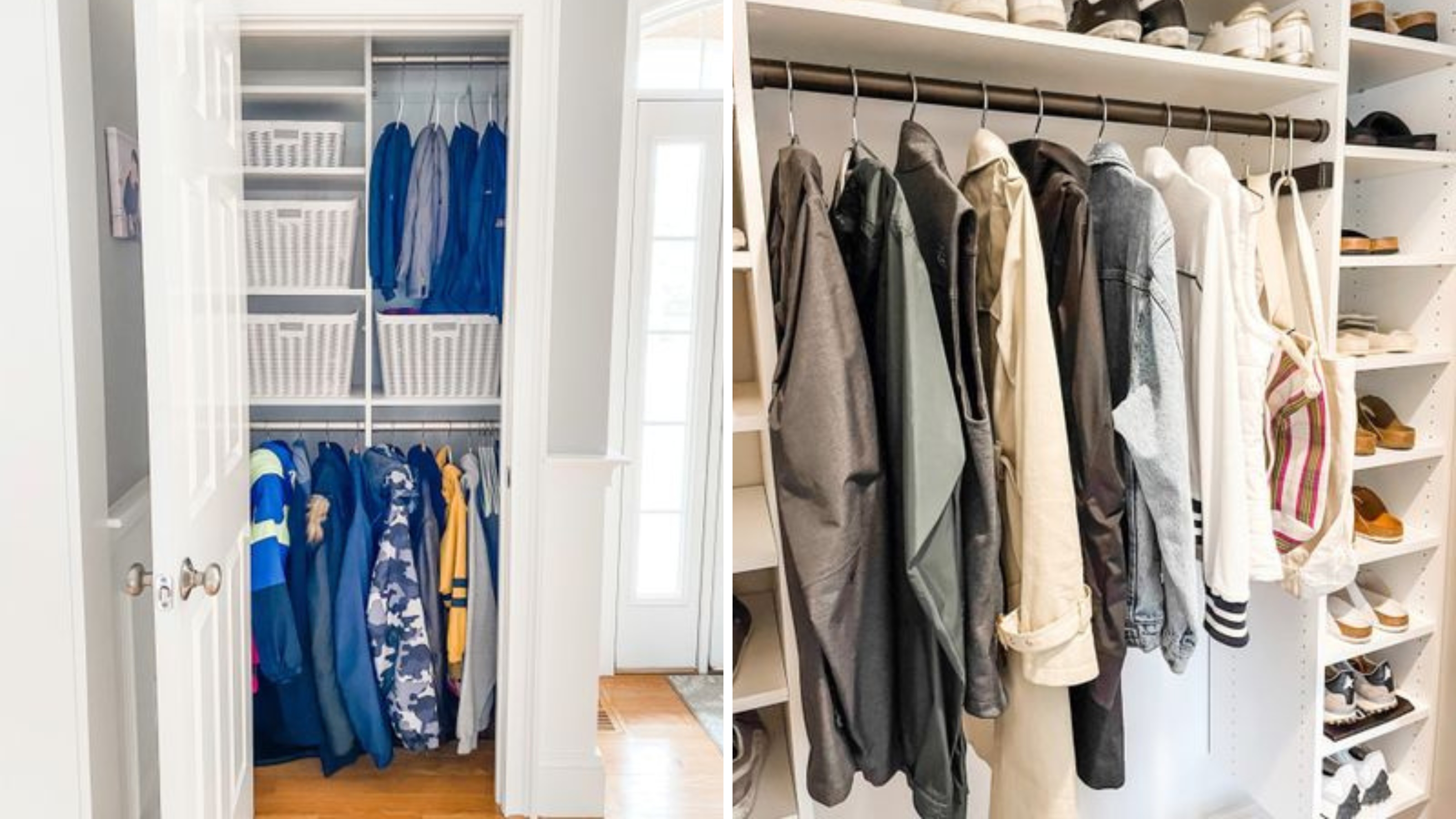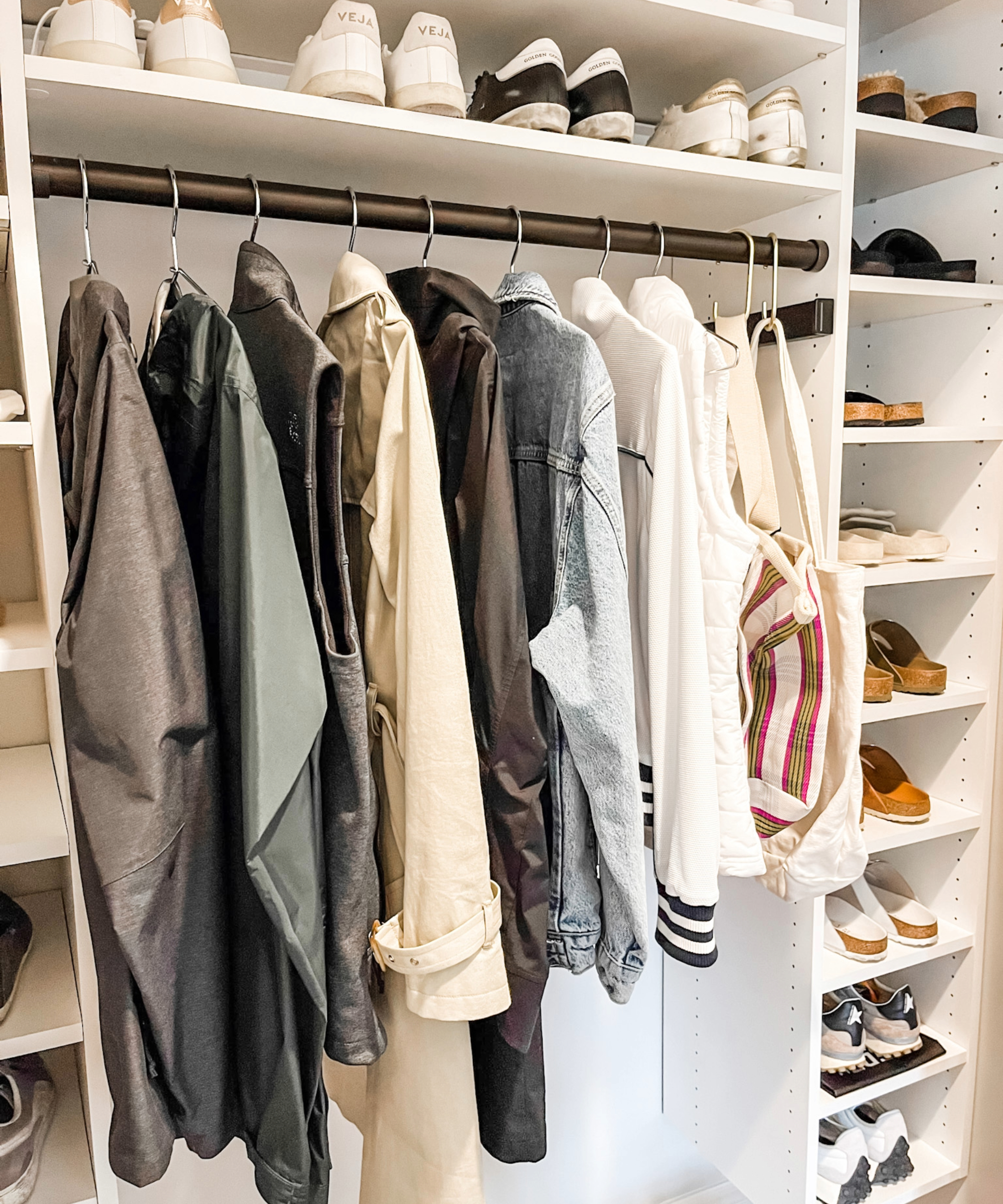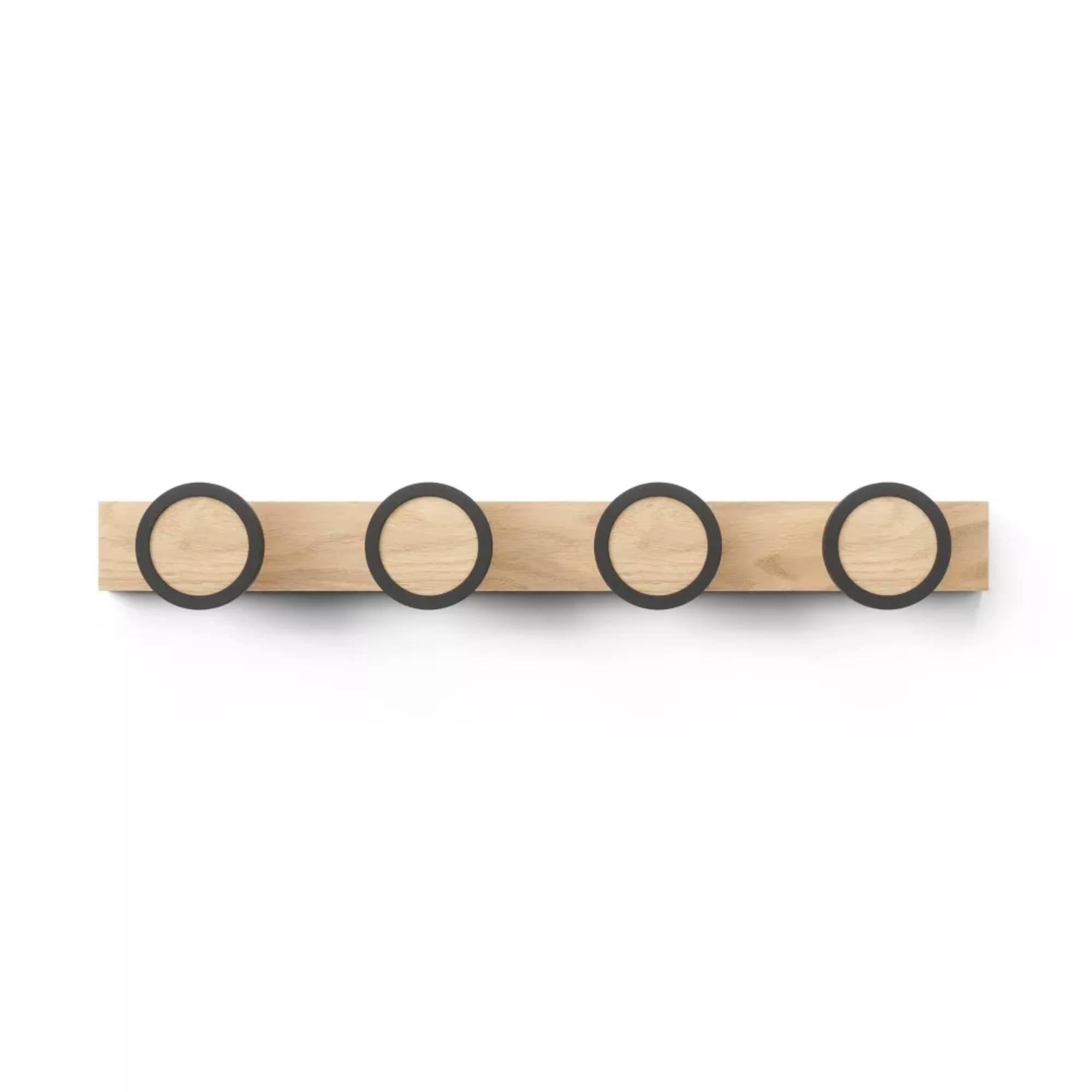
With some clever small entryway closet ideas, you can turn the smallest, most awkward of spaces into a functional, streamlined closet that caters to everyone, guests included.
Alongside our personal experience in dealing with small entryway closets (or no entryway closet at all, in some cases, so think yourself lucky), we’ve quizzed those in the know for their top tips on how to utilize the space you do have to best effect.
From savvy storage to space-boosting buys, we’ve got you covered on all things practical. And if you’re wondering how to organize a small entryway so it’s warm and inviting, we’ve ticked that off, too.
Small entryway closet ideas
It’s all well and good decorating a small entryway, but without sensible solutions in place, it’ll descend into a dumping ground. Coats and hats, shoes and shopping bags, last week’s sweaty sports stuff (gross)... there’s no small entryway idea stylish enough to make up for all of that. So it’s time to take storage seriously, starting with the closet.
1. Maximize hanging space
You’ve got plenty of hanging space but you’re short on shelving… the solution? A cubby-style hanging organizer, of course. Dedicate a ‘shelf’ for each family member, or categorize by item; gloves, scarves, school bags, lunch boxes, and so on.
Closet organizers are big business, not just for entryways, but when organizing a bedroom, too. We love this foldable closet organizer from Amazon with over 11k reviews.
Depending on what you’ve got to store, you could swap in a more tailored solution like purse hangers, scarf hooks, or an extra closet rod or two for overflow coats.
2. Give ‘out-of-reach’ space a purpose

The number one rule when organizing a closet? Never underestimate space of any kind. According to professional organizer and home stager Amanda Wiss, founder of Urban Clarity, all it takes is a bit of savvy storage and a sensible organization system and the sky’s the limit — quite literally in this case.
“Depending on the height of your closet, you can feasibly create an extra three to four feet of usable storage space above your hanging rods by installing metro shelving, or another configurable shelving design. Line it with lidded bins (to prevent dust) and use them to store items you don’t need ready access to,” she says.

Amanda Wiss is the founder of Urban Clarity, a home-organizing company based in NYC. She is also the founder of home staging studio Urban Staging, whose design-savvy team gets homes market-ready, to intrigue brokers and buyers alike. The two companies work in conjunction to do full move management.
3. Bespoke storage
They tend to be on the pricier side, but custom-made inserts are arguably the best way to make the most of tricker closet spaces. If you're working with a particularly awkward space, like a closet underneath the stairs, some DIY small entryway projects are a great way to tackle it.
As well as maximizing every inch of space, you have the benefit of designing them to suit your particular organizational needs — built-in cubbies to store handbags and shoes, for example. Or perhaps a pull-out rail to make rifling through coats easier.
4. Rearrange shelving

If you’re struggling to fit things in, ask yourself — are my existing closet shelves adjustable? You may not realize it, but many are (like this closet system from Wayfair). If so, move them around to better fit what you want to store.
“Whether you’re building individual cubbies for school books and bags, making space for sports equipment, creating height for hockey sticks and an ironing board, this lends a custom feel and prevents wasting precious vertical space,” advises Lara Duffy, founder of Lennox & Co Organizing.

As a certified nurse practitioner, Lara Duffy’s journey into professional organizing marries the art of well-being with the skill of decluttering and order.
5. Use the back of the door
Utilizing vertical space in a small closet can be a real game changer, and we’re not just talking walls either. From over-the-door pocket organizers, like this organizer from Target, to simple Command Hooks for holding coats, purses, and bags, sensible small entryway storage ideas employed on the back of the door have the potential to effectively double your small closet’s capacity.
“Modular over-the-door designs, like this organizer from The Container Store, are great as you can customize storage according to your needs. Move baskets up and down the track, depending on what you’re storing and the height you require it at — handy if you’ve got children of varying ages," says professional organizer Shannon Krause, co-founder of Tidy Nest.

Shannon Krause is a Certified Professional Organizer and owner of Tidy Nest — an award-winning organizing and relocation management company. Her unique approach blends her expertise in professional organizing with her skills as a Certified Reiki Master, integrating energy work to enhance her client's experiences.
6. Group smaller items into baskets and bins

Categorizing and corralling smaller items (from gloves and hats to school-related ‘stuff’ and pet paraphernalia) makes them easier to find, even more so if you store them in transparent containers, like these sturdy plastic ones from The Container Store. Always measure up before investing, so you’re not left with any dead space.
“If floor space allows, purchase a cube storage unit, (we like this one from Wayfair). Categorize items into each section or bin, hats in one section, scarves in another, umbrellas in another, and so on until all of your accessories have a home”, recommends professional organizer Lauren Saltman, founder of Living. Simplified.

Price: $39.99

Price: $25

Price: $29.99

Lauren Saltman is a professional organizer and owner of Living. Simplified, based in the seacost area of New Hampshire. She believes that a clutter-free and well-organized home can help to foster peace of mind in other parts of our lives, giving us the freedom to spend time doing what we love most.
7. Rotate items seasonally

It may shock you to hear that not every single coat and pair of shoes you own needs to live in the entryway at all times. Sounds obvious right? But we can guarantee you’ve got way more than you actually need taking up space in your already overflowing closet.
Rather than cramming everything in, reserve it for items you’re using regularly — think seasons. Swap ski coats for beach bags, snow boots for sandals, and so on. Try storing your excess clothes in your bedroom using compression bags (like these vacuum storage bags from Amazon). They're great for bulky items like puffer jackets.
8. Keep coat hooks under control
It may be obvious but don’t underestimate this small entryway coat storage idea. The humble coat hook goes a long way in a small or narrow entryway, offering easy access to outing essentials. We’d recommend mounting them on a wall next to your closet, rather than inside it, to free up a bit of space. You can hang these matte black Command Hooks from Amazon just about anywhere plus, they look great, too.
Like with any ‘on-show’ storage, you’ll need to keep it looking nice. Edit your items seasonally, and limit each family member to one or two at a time. Try to leave a couple of hooks free for guest use if you can.
If you have little ones in your household, consider doubling your hanging capacity with dual-height coat hooks. They’re more likely to hang their own bags and coats up after school if they’re easy to access.

Price: $24.19

Price: $31.49

Price: $12.99
9. Stack up shoes
When it comes to practical shoe storage ideas for a small entryway, going high instead of wide is an expert-approved tactic when organizing small spaces, particularly narrow ones. Tiered racks or stackable shoe boxes (like these from Target) both work well, but if you’re restricted by shelving, try these space-boosting shoe risers from Amazon, designed to stack shoes without damage.
Some experts suggest using wall-hung pocket organizers for holding shoes, but Amanda advises against this. “I’d always recommend floor-based shoe racks, to keep germ and stinky shoe smells as far away from coats and jackets as possible,” she says.
However you choose to store them, you ideally want shoes put away neatly each time to keep them in good condition. But if that’s not realistic, (kids aren’t renowned for their tidiness, let’s face it) consider placing a large, sturdy basket or ‘shoe drop zone’ in the bottom of your closet.
10. Invest in the right hangers

It may sound simple, but investing in decent hangers can make a huge difference to how space-efficient your small closet is — and how easy it is to keep tidy, too.
“I’d recommend wooden hangers for heavy coats and flocked designs for slippery raincoats and light-weight jackets to help keep them in place. Always opt for slim versions to ensure you’re maximizing on hanging space’, says professional organizer Diane Quintana, founder of Release, Repurpose, Reorganize.
If you need some sturdy storage, pick up this pack of 30 wooden hangers from Amazon.

Diane is a Certified Professional Organizer in Chronic Disorganization based in Atlanta, Georgia. She earned a Hoarding Specialist credential from the Institute for Challenging Disorganization and has co-authored a book called: ‘Filled Up and Overflowing: What to do when life events, chronic disorganization or hoarding go overboard.’
FAQs
Does an entryway need a closet?
There’s no doubt that a closet is a useful addition to an entryway, but we wouldn’t say you need one. From stylish coat hooks and wall-mounted shelves to freestanding furniture such as benches and chests, there are plenty of ways you can integrate storage into your space. In fact, some experts argue that not having a closet actually makes for a more organized entryway overall — you’re more likely to stay on top of clutter if you don’t have somewhere to hide it!
How do you start organizing a small entryway closet?
Your first job is to clear the clutter and set aside out-of-season items. Group what’s left into categories so you’ve got a clear idea of what you need to make room for.
Consider how best to store these items in the space you’ve got, and invest in appropriate organizers to suit. Keep like items grouped together, and inform family members of where to find things. Encourage them to put things back as soon as they come in — lead by example on this one!
There are so many great ways of maximizing space in a small entryway closet, that it's easy to get carried away, but according to the experts, the phrase ‘too much of a good thing’ rings true here:
“It’s lovely to have an entryway closet of any size, but if it’s so stuffed with coats, hats, gloves, and shoes that you can’t actually squeeze another thing in, it becomes a place to avoid, rather than use, which defeats the point entirely,” says Diana.
Be sure to prioritize storage and organization solutions to suit your space and your needs, along with regular seasonal clear-outs. That’s the secret to a functional small entryway closet, and the best way to make a small entryway look inviting.
Join our newsletter
Get small space home decor ideas, celeb inspiration, DIY tips and more, straight to your inbox!
After the arrival of her second son – and subsequent departure of any free time outside of his unpredictable nap schedule (!) – seasoned writer Tara King decided to move on from her position as a Content Editor and enter the exciting world of freelance, covering interior design, DIY and lifestyle. Alongside features for Realhomes.com, Tara writes for Ideal Home, Style at Home, Country Homes & Interiors and other interiors publications. When she’s not working or ‘mumming’, she can be found (hiding) in the garden, attempting DIY projects… with varying levels of success!